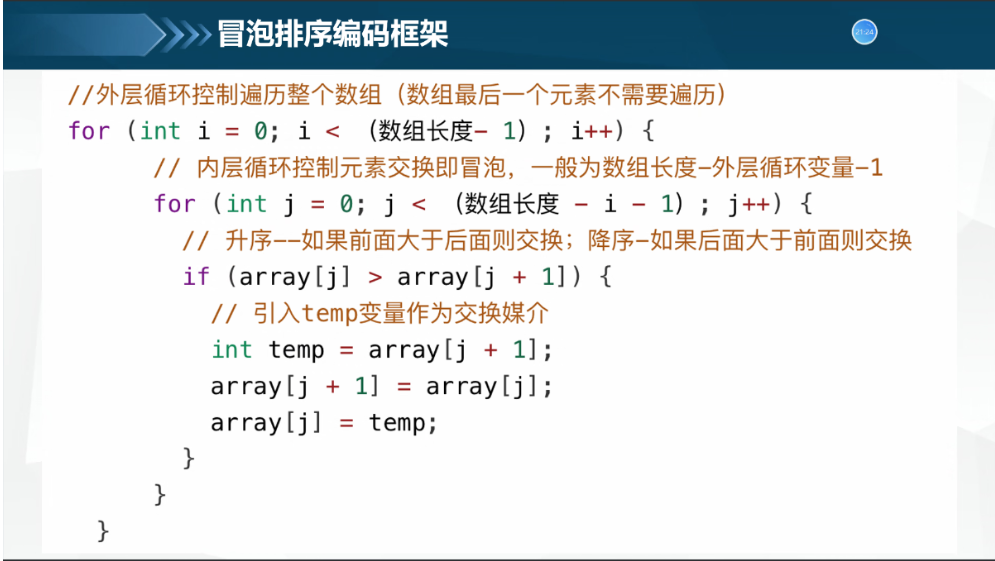4.2 数组排序算法
4.2.1 冒泡排序
冒泡排序是一种简单的排序算法,它重复地遍历要排序的数列,一次比较两个元素,如果它们的顺序错误就把它们交换过来。遍历数列的工作是重复地进行直到没有再需要交换,也就是说该数列已经排序完成。这个算法的名字由来是因为越小的元素会经由交换慢慢“浮”到数列的顶端。
public class BubbleSort {
public static void main(String[] args) {
int[] arr = {64, 34, 25, 12, 22, 11, 90};
bubbleSort(arr);
System.out.println("排序后的数组: ");
for (int i : arr) {
System.out.print(i + " ");
}
}
public static void bubbleSort(int[] arr) {
int n = arr.length;
for (int i = 0; i < n - 1; i++) {
// 最后一个元素已经在正确的位置上,所以每次减少比较的元素数量
for (int j = 0; j < n - i - 1; j++) {//n-i-1 -> (n-1)-i 减掉已经排好的i个元素
// 交换如果发现元素的顺序错误
if (arr[j] > arr[j + 1]) {
// 交换 arr[j] 和 arr[j + 1]
int temp = arr[j];
arr[j] = arr[j + 1];
arr[j + 1] = temp;
}
}
}
}
}

4.2.2 选择排序
选择排序是一种简单直观的排序算法,它的工作原理是每一次从待排序的数据元素中选出最小(或最大)的一个元素,存放在序列的起始位置,直到全部待排序的数据元素排完。
public class SelectionSort {
public static void main(String[] args) {
int[] arr = {64, 34, 25, 12, 22, 11, 90};
selectionSort(arr);
System.out.println("排序后的数组: ");
for (int i : arr) {
System.out.print(i + " ");
}
}
public static void selectionSort(int[] arr) {
int n = arr.length;
for (int i = 0; i < n - 1; i++) {
// 找到最小元素的索引
int minIndex = i;
for (int j = i + 1; j < n; j++) {
if (arr[j] < arr[minIndex]) {
minIndex = j;
}
}
// 将找到的最小元素交换到当前位置
int temp = arr[minIndex];
arr[minIndex] = arr[i];
arr[i] = temp;
}
}
}
4.2.3 快速排序
选择一个基准元素,将数组分成两部分,使得比基准小的元素在左边,比基准大的元素在右边,然后递归地排序这两部分
public static void quickSort(int[] array, int low, int high) {
if (low < high) {
int pi = partition(array, low, high);
quickSort(array, low, pi - 1);
quickSort(array, pi + 1, high);
}
}
public static int partition(int[] array, int low, int high) {
int pivot = array[high];
int i = (low - 1);
for (int j = low; j < high; j++) {
if (array[j] < pivot) {
i++;
int temp = array[i];
array[i] = array[j];
array[j] = temp;
}
}
int temp = array[i + 1];
array[i + 1] = array[high];
array[high] = temp;
return i + 1;
}
4.2.4 插入排序
通过将每个元素插入到已排序部分的适当位置,逐步构建排序序列。
public static void insertionSort(int[] array) {
int n = array.length;
for (int i = 1; i < n; i++) {
int key = array[i];
int j = i - 1;
while (j >= 0 && array[j] > key) {
array[j + 1] = array[j];
j = j - 1;
}
array[j + 1] = key;
}
}
4.2. 排序算法方法(sort)
public static void sort(Object[] a)
- 对指定对象数组根据其元素的自然顺序进行升序排列。同样的方法适用于所有的其他基本数据类型(Byte,short,Int等)